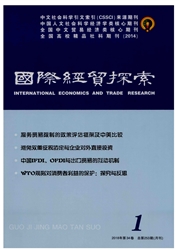

 中文摘要:
中文摘要:
近年来中国实施“走出去”发展战略,在海外大量并购资源能源类企业。从宏观来讲“南北均衡”模型决定了“中国制造一欧美消费”的格局;微观分析,我国基础设置发展水平和要素禀赋结构共同促成我国成为制造业大国,具体来说,硬性基础设置促进制造业出口的扩展边际和集约边际.软性基础设置提供与现有技术水平相匹配的知识产权制度以降低风险。在国际形势日益复杂的情况下,中国企业为了保证制造业的上游供给,在海外进行了大量资源能源并购,将劣势转化为跨国公司内部化优势。
 英文摘要:
英文摘要:
In order to carry out a "going out" strategy, Chinese enterprises have conducted a large number of mergers and acquisitions of overseas resource and energy enterprises in recent years. From a macro perspective, the "North-South equilibrium" leads to the pattern of "made in China-purchased in the West"; from a micro perspective, the development of infrastructure and the structure of factor endowments in our country promote China to be a big manufacturing country together. In details, hard infrastructure promotes the extended margin and intensive margin of manufacturing exports; soft infrastructure provides the intellectual property system which is matched with the existing technology to reduce risks. In order to ensure the upstream supply of manufacturing industry in an increasingly complex international situation, Chinese manufacturing enterprises have done a lot of mergers and acquisitions in resource and energy areas, internalizing disadvantages into multinational internal advantages.
 同期刊论文项目
同期刊论文项目
 同项目期刊论文
同项目期刊论文
 期刊信息
期刊信息
